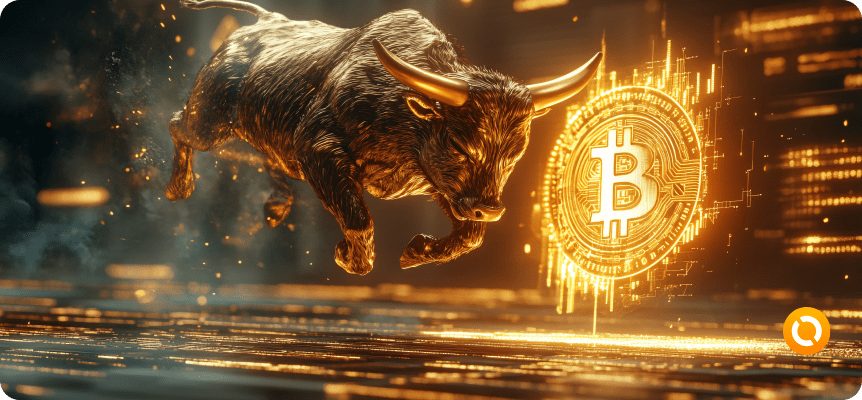Unlike investing, where the focus is on long-term growth in the value of coins, trading involves frequent transactions and quick decisions.
An investor is someone who “holds” in anticipation of growth, while a trader is someone who acts in the moment, using analysis and market signals.
Why is stock trading popular in 2025?
With growing interest in digital assets and improved exchange infrastructure, crypto trading has become much more accessible in 2025.
Mobile apps, advanced charts, automated assistants and low fees have emerged, attracting both newcomers and experienced market participants.
In 2025, exchange trading, especially in the digital asset space, is experiencing a real boom. This is due to several key factors that have made this type of activity accessible, attractive and potentially profitable for a wide audience – from private investors to institutional players.
1. Growing interest in digital assets
Cryptocurrencies, tokens, stablecoins and NFTs are no longer perceived as exotic or temporary fads. In recent years, they have become an integral part of the global financial market.
The mass adoption of digital assets is fueled by both institutional investment and attention from governments developing their own digital currencies (CBDCs).
This creates a sense of reliability and promise for the crypto market, which attracts millions of new traders around the world.
2. Development of technological infrastructure
Modern trading platforms in 2025 offer users intuitive interfaces, support for multiple analysis tools, and the ability to use artificial intelligence and algorithmic trading.
Thanks to this, trading has become less complicated and more automated. Even a novice user can launch a bot that will trade according to specified strategies, minimizing risks and increasing the chances of profit.
3. Mobility and accessibility
The development of mobile trading applications has allowed people to trade from almost anywhere in the world. Applications have become lightweight, fast and functional, including real-time analytics, notifications, the ability to open and close trades in one click.
This has made it possible to turn stock trading into a daily activity that can be combined with work, study or travel.
4. Reduced fees and barriers to entry
One of the main reasons for the popularity of trading was the sharp reduction in commissions and entry thresholds. Previously, participation in exchange trading required significant capital investments, and commissions “ate up” most of the potential profit.
Today, you can start with minimal amounts, and some platforms even offer trading without commission or with cashback systems, which makes the process even more attractive for beginners.
5. Education and Community
In 2025, a huge number of educational resources, courses, YouTube channels, Telegram and Discord communities are dedicated to trading and investing. This creates an effect of involvement and support: beginners can quickly learn and get advice from more experienced participants.
It is also becoming increasingly possible to participate in “copy trading,” when a user repeats the actions of successful traders in automatic mode.
6. Macroeconomic instability and the search for alternatives
Instability of traditional financial systems, inflation, geopolitical conflicts and declining confidence in national currencies are forcing people to look for alternative ways to save and increase their wealth.
Digital assets and stock exchange trading are becoming more than just a hobby for many, but an important element of financial survival and strategic planning.
TOP Strategies for Cryptocurrency Trading: From Beginner to Professional
Long-term strategies (HODL)
HODL is a strategy of buying cryptocurrency with the aim of holding the asset for a long time. It is suitable for those who do not want to monitor the market every day.
Most applicable to large coins: Bitcoin, Ethereum and other top 10 tokens.
Short-term strategies (day trading, scalping)
These approaches require constant presence in the market. Day trading involves opening and closing positions throughout the day.
Scalping is an ultra-short-term strategy where a trader makes dozens of trades over a period of several hours, making a profit from minimal price movements.
Arbitrage between exchanges
The essence of the strategy is to use the difference in price of the same asset on different exchanges.
For example, if Bitcoin is worth $40,000 on Binance and $40,300 on OKX, a trader can buy on one exchange and sell on the other, making money on the difference.
Trading with the trend and using technical analysis
Following the trend is the basis of successful trading. This includes indicators (Moving Average, RSI, Bollinger Bands) and chart patterns.
Technical analysis helps determine the moment of entry and exit.
Advanced Strategies for Professionals: How to Increase Profitability
Algorithmic trading: automation of transactions
Scripts and bots make deals automatically according to a given algorithm. Allows you to exclude emotions and trade 24/7. Used on exchanges that support API and third-party trading platforms.
Margin Trading: How to Use Leverage
Leverage allows you to open a position for an amount greater than your balance. This increases potential profit, but the risks also increase. Suitable only for experienced traders.
Blockchain Data Analysis: What Can Be Learned from Transaction Chains?
On-chain analytics allows you to see how large investors (whales) move assets, which coins are trending, and which networks are used most often.
This is an added benefit in assessing market sentiment.
Statistical Arbitrage: Finding Anomalies in the Market
This strategy is based on statistical models and historical correlation of assets. When the price deviates from the expected value, transactions are made to return to the mean.
Building Your Own Trading Models: Examples and Tools
Professionals create their own strategies using TradingView, Pine Script, Python or even Excel. This allows them to take into account unique parameters and test hypotheses on historical data.
Risk Management in Crypto Trading: How to Minimize Losses
What is Stop Loss and Take Profit?
Stop Loss limits losses by automatically closing the deal when a certain level is reached. Take Profit — fixes the profit. These tools are important for protecting capital and trader discipline.
Portfolio Diversification: Why is it Important?
Don’t keep everything in one coin. Splitting funds between several assets reduces overall risk. It’s better to have shares in different sectors: DeFi, GameFi, stablecoins, infrastructure tokens.
Emotions in Trading: How to Keep Your Cool
Emotions are the enemy of a trader. Greed, fear of missing out (FOMO), panic – all this prevents you from making informed decisions. Using strategies, limits and automation helps you stay cool.
Tools and indicators for successful trading: what you need to know
Basic types of graphs and their analysis
Candlestick charts are the main type of display. They show the opening price, closing price, maximums and minimums. Linear and bar charts are also used.
Popular indicators: RSI, MACD, Moving Averages
RSI shows overbought/oversold asset. MACD — moving average intersection. MA — moving average for the selected number of periods.
How to use orders (market and limit)
A market order is executed instantly at the current price. A limit order allows you to set the desired purchase/sale price. Stop orders are also used to automate actions.
Predictions for 2025: Which Strategies Will Work?
Promising Coins and Tokens for Trading
L2 solutions, staking and DePIN tokens are popular in 2025. Attention is paid to the Ethereum, Arbitrum, Solana ecosystems, as well as new tokens from the GameFi and AI sectors.
Algorithmic Trading: The Future of Trading?
The speed and accuracy of algorithms surpass the human factor. More and more traders use trading bots, especially on highly liquid pairs. This trend will only grow.
Conclusion: Key Findings and Recommendations
Cryptocurrency trading is not a game of chance, but a systematic process that requires knowledge, discipline, and a clear strategy. The choice between short-term trades, medium-term trading, or long-term investments depends on your experience, goals, and risk tolerance.
It is important for beginners not to chase quick profits, but to focus on learning and risk management.
Professionals – keep a cool head and constantly adapt to changing market conditions. Regardless of the level, all traders should remember: the key to success lies not only in the tools, but also in the ability to control emotions and make balanced decisions.
The cryptocurrency market is volatile and unpredictable, but for those who are ready to learn and develop, it opens up truly broad opportunities.
FAQ
💡 How to choose cryptocurrency for trading
Before you start trading, it is important to choose the right cryptocurrency . Each coin has its own level of volatility , trading volumes, and liquidity . For example, USDT is a stablecoin pegged to the dollar, which is convenient to start with, especially if you are just taking your first steps. To make money on exchange rate fluctuations, you need to carefully study the market and monitor price changes and news.
🔐 Security and storage: creating a wallet
To trade, you need not only an exchange, but also a secure cryptocurrency wallet . It can be online, software or hardware – the choice depends on the goals and risk level. When creating an account on the exchange, make sure that you have access to funds, even if you lose your password or the service fails. It is also useful to enable two-factor authentication – security in the crypto world is of paramount importance, because you can lose funds due to negligence in an instant.
📈 Buy or Sell: How to Find Profitable Moments
Trading is a constant work with risks. To buy at a favorable price and sell with a profit, study the basic trading strategies. It is important not only to follow the charts, but also to understand the behavior of the market in different situations . For example, during periods of high volatility , you can quickly earn money or lose a small deposit. Therefore, beginners are advised to start with small amounts and gradually study different approaches.
🏦 Deposit and liquidity: what to consider
Before making a deposit , check how liquid the cryptocurrency you choose is. High liquidity means that you will be able to quickly buy or sell the asset without significant losses. Some cryptocurrency exchanges provide automatic liquidity calculation services , which is convenient for beginners. It is also worth paying attention to reliable platforms that support a wide range of assets – from BTC and ETH to USDT and altcoins.
🛡 Exchange reliability and user support
Choosing an exchange is one of the most important stages. Reliable exchanges provide not only high liquidity , but also round-the-clock support, a clear interface and fast deposits/withdrawals. Be sure to study what services the platform provides: whether there is a mobile application, how the wallet is structured , and what happens in case of technical failures. Good support will help to avoid possible problems and maintain access to your assets.
📊 Analysis and Strategies: The Key to a Stable Income
To get a stable income , it is important not only to act on intuition, but also to apply proven strategies. Learn the basics of fundamental and technical analysis, set up signals and try using automatic services . Experienced traders recommend not to strive for quick profits in the first month of trading, but to focus on understanding the market. This will help make informed decisions and reduce risks.











